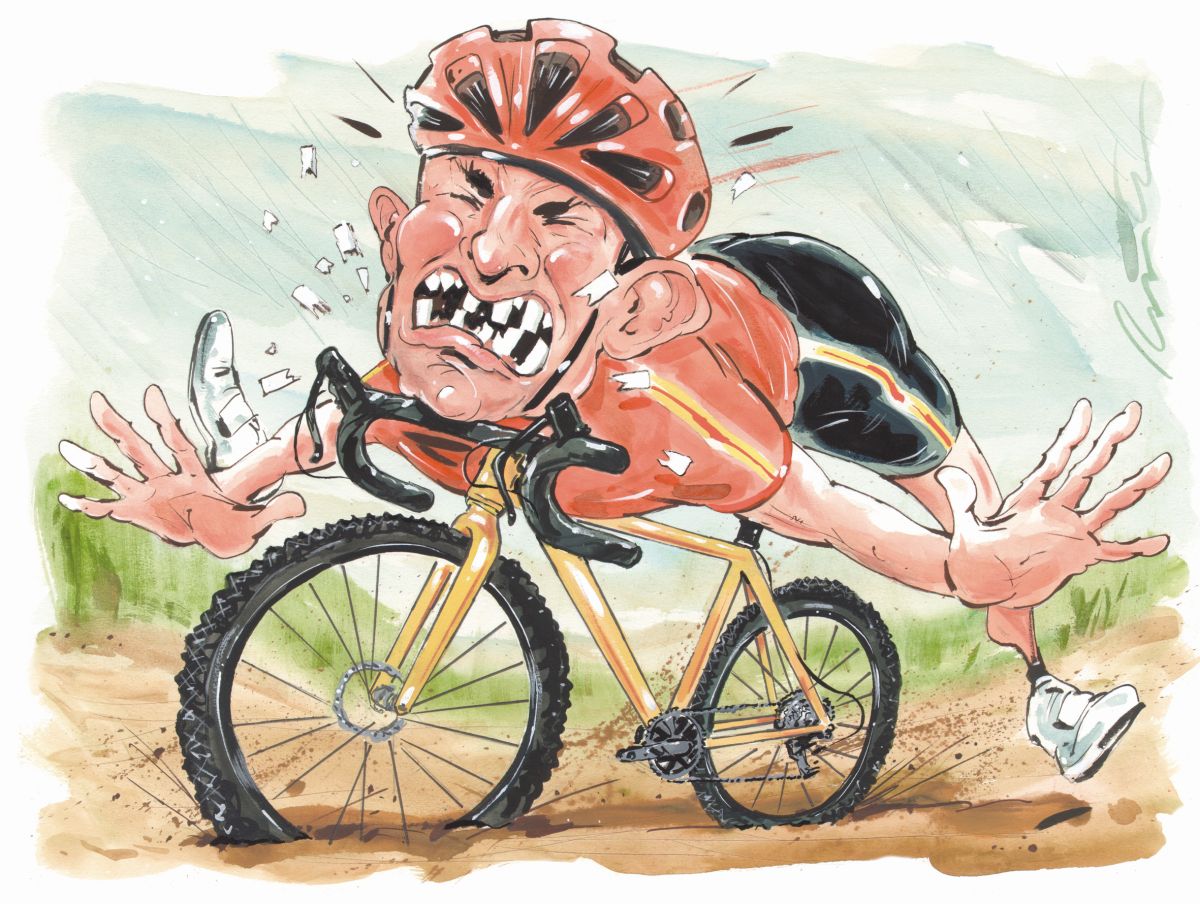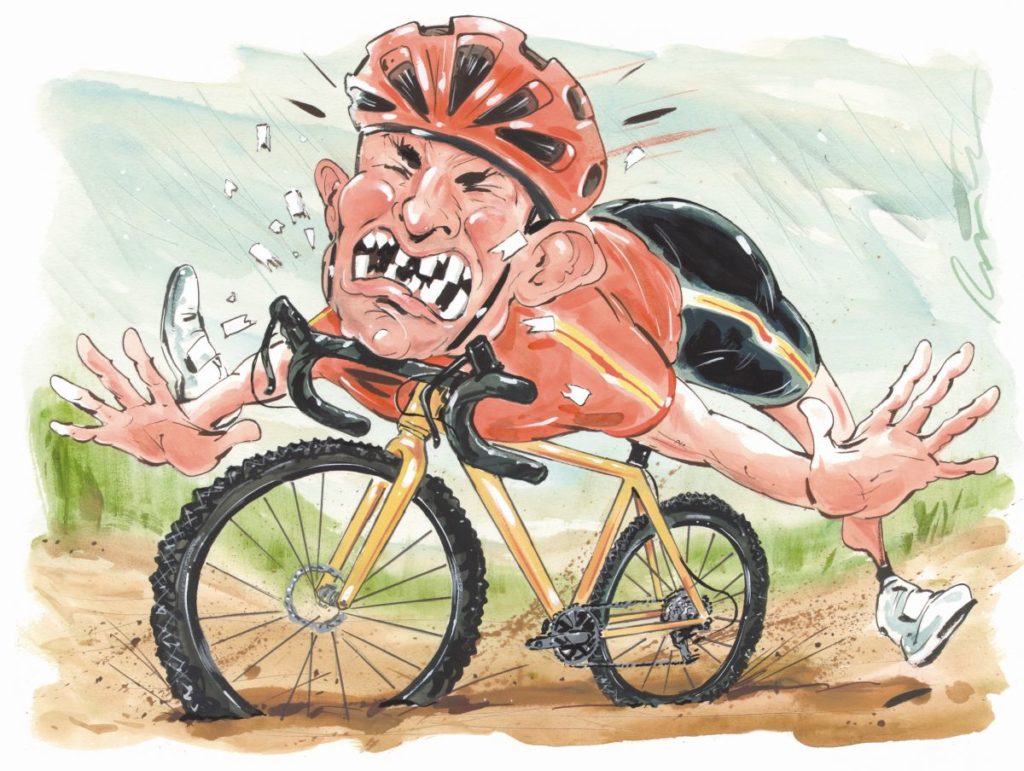Crossed by ’cross: Showing the muddy discipline no flexibility
Cranky sounds off on riding his cyclocross the way he wants to

by James “Cranky” Ramsay

Those who know me well can tell you I’m one of the least flexible people they’ve ever met. Most of these people would be referring to my outlook on life, but they’re missing half the story. Indeed, my inflexibility is more than just an attitude: it’s a biomechanical shortcoming.
By now, many of you will not be surprised to learn that there’s yet something else wrong with me. But this woe is special because it’s more problematic than some of my other deficiencies. My lack of physical flexibility prevents me from fully engaging in many sports. At the age of three, I discovered that unlike other children in the preschool class, I was unable to sit cross-legged. My knees simply wouldn’t go flat. The teacher thought I was being obstinate, but my hip joints had a limited range of motion. No amount of cajoling or encouragement could change this fact.
RELATED: Yoga for cyclists: Strength and flexibility session
At this point you may be wondering whether sitting cross-legged should really be considered a sport, and why I’m writing about my inflexible hips in a magazine devoted to cycling. To the first question, I say, don’t be so narrow-minded. It’s people like you who tried to keep rhythmic gymnastics and beach volleyball out of the Olympic Games. To the second question, well, it all has to do with my cyclocross bike.
Cyclocross? What can hips possibly have to do with cyclocross? Quite a lot, in fact – but this only becomes apparent if you try to use a cyclocross bike for its true purpose. I’ve owned a ’cross bike for years. I bought my first at the recommendation of my local bike shop owner when I showed up on my carbon road bike for a group ride on a wet, slushy day in early winter.
“You can’t ride your good bike in this weather, Jimmy,” said Ennis, the shop owner.
“Why not?” I asked in return.
“Because the salt on the road will eat your frame and destroy your drivetrain,” came the answer.
RELATED: 10 reasons to ride with Zwift this winter
Ennis, helpful as always, had the perfect solution: an aluminum ’cross frame, built up with unglamorous but entirely serviceable parts. I rode it for years until replacing it with a truly glamorous titanium ’cross bike, which I still own and ride today.
But here’s the thing: I don’t ride my ’cross bike the way it’s meant to be ridden – leaping off it to then jump over barriers, carrying it on my shoulder while running up muddy hills or gracefully swinging my leg over at speed, landing perfectly astride the saddle as I seamlessly clip in and resume pedalling.
No. My ’cross bikes have been used 99.9 per cent of the time as foul-weather road bikes, winter bikes, commuters or machines to be ridden on gravel roads and hardpack.
So what of the remaining 0.1 per cent of the time? Well, that’s accounted for by the single occasion in which I joined a cyclocross clinic, in an ill-advised choice ignoring my physical limitations.
I was encouraged to take part in this misadventure by the publisher and several of the staff of this magazine. My protestations about being injury-prone and not being able to jump on and off bikes with ease fell on deaf ears.
“You’ll get it, Jimmy,” they said.
RELATED: First look: Norco Threshold C Force 1
But I didn’t.
To give myself some credit, I tried, and I didn’t give up. I could have packed it in when I heard a cracking sound come from my pelvic region as I swung my leg over the bike and jumped off, but I kept going. I could have packed it in when I repeatedly landed crotch-first on the top tube when trying to remount the bike while running. And I should have packed it in when I slipped running up a hill while shouldering the bike, smashing my face into the stem.
But I kept on going. After about 90 minutes, the guy running the clinic told us all it was time to pack it in.
I rode home, feeling sore but relieved that I could simply stay seated on the bike and pedal it without interruption. I was also pleased with myself for persevering through a painful experience. I remember thinking optimistically that it would be easier the next time.
Any thoughts of a next time evaporated the following morning when I tried to get out of bed. My hips had become inflamed during the night, and merely putting one foot in front of the other was excruciatingly painful. It took me about five days (and a lot of stretching and mobility exercises) to feel better.
RELATED: Misadventures of a DIY bike mechanic
I still ride my ’cross bike. I love it dearly (as I do all my bikes). But I ride it the way that works for me, and barring the need to stop and get off mid-ride, that means swinging a leg over precisely twice each time I take it out: once at the beginning of the ride, and once at the end.
